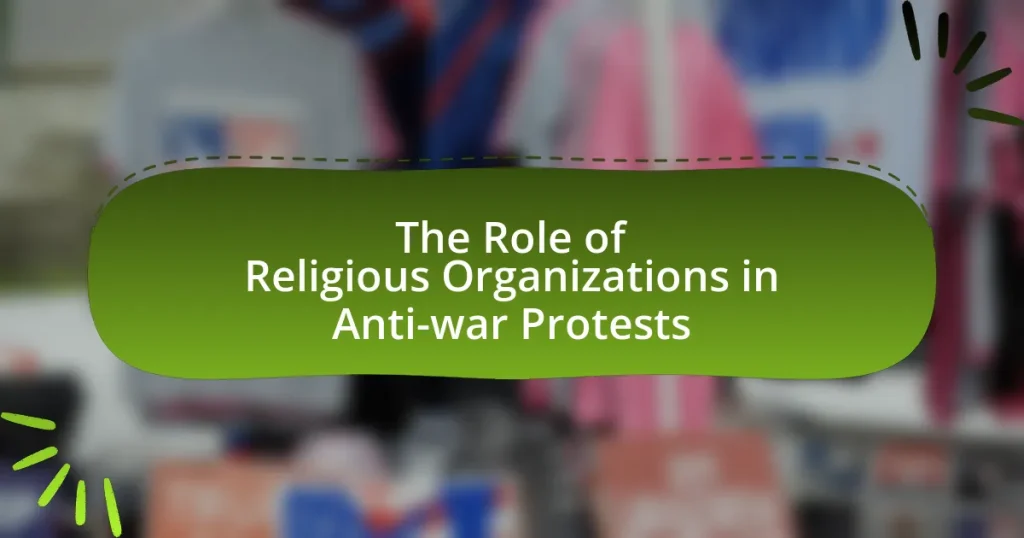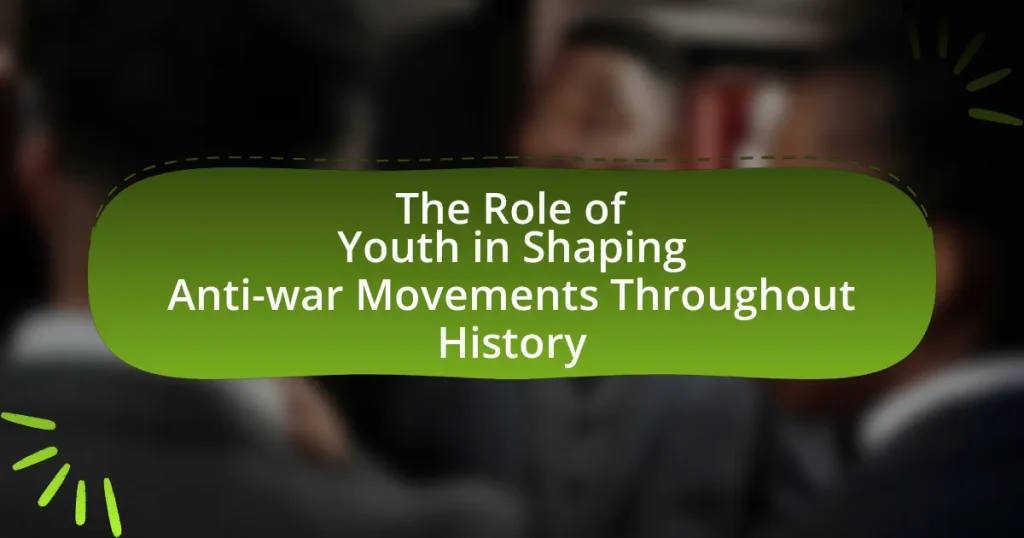The article examines the significant role of art and music in historical anti-war demonstrations, highlighting their effectiveness as tools for expression, mobilization, and emotional resonance. It discusses various forms of artistic expression, including protest songs and visual art, that have been utilized in movements such as the Vietnam War protests and the Gulf War protests. The article also explores the psychological impacts of these artistic expressions on participants, their ability to foster community and solidarity, and the lessons contemporary movements can learn from historical examples. Additionally, it addresses the challenges modern movements face in using art and music, as well as best practices for effectively integrating these elements into protests.
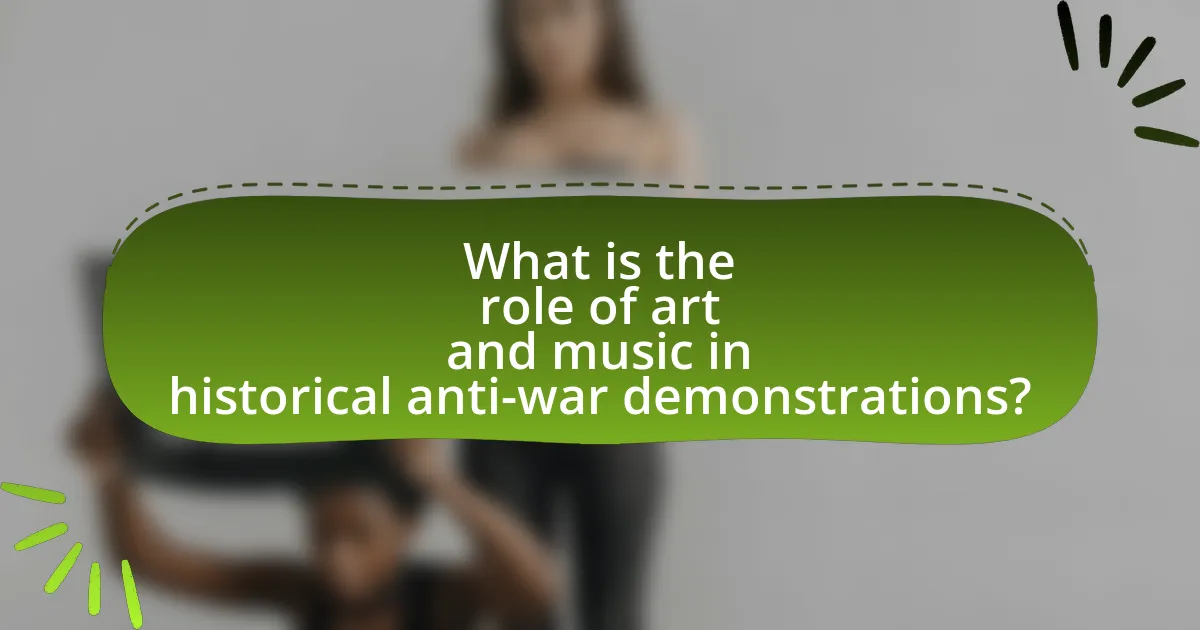
What is the role of art and music in historical anti-war demonstrations?
Art and music play a crucial role in historical anti-war demonstrations by serving as powerful tools for expression and mobilization. They convey emotional messages that resonate with the public, often encapsulating the sentiments of dissent and the desire for peace. For instance, during the Vietnam War, songs like “Give Peace a Chance” by John Lennon became anthems for the anti-war movement, uniting protesters and amplifying their message. Additionally, visual art, such as posters and murals, has historically been used to critique war and promote peace, exemplified by the iconic “Make Love, Not War” imagery of the 1960s. These artistic expressions not only foster community among activists but also attract media attention, thereby increasing public awareness and engagement with anti-war sentiments.
How have art and music been utilized in various anti-war movements?
Art and music have been utilized in various anti-war movements as powerful tools for expression, mobilization, and emotional resonance. For instance, during the Vietnam War, songs like “Fortunate Son” by Creedence Clearwater Revival and “Give Peace a Chance” by John Lennon became anthems that encapsulated the sentiments of opposition to the war, galvanizing public sentiment and encouraging protests. Additionally, visual art, such as the iconic “Peace” symbol and protest posters, served to visually communicate anti-war messages, making them accessible and impactful. Historical events, like the 1969 Woodstock Festival, showcased music as a unifying force for the anti-war movement, drawing hundreds of thousands together in a shared message of peace. These artistic expressions not only reflected societal discontent but also inspired collective action, demonstrating the significant role of art and music in shaping the narrative and momentum of anti-war efforts.
What specific forms of art have been prominent in these demonstrations?
Visual art, particularly protest posters and murals, has been prominent in anti-war demonstrations. These forms of art serve as powerful tools for conveying messages and mobilizing public sentiment against war. For instance, during the Vietnam War protests, artists created iconic posters that depicted anti-war sentiments, such as the famous “Make Love, Not War” slogan. Additionally, music, including protest songs, has played a significant role in these demonstrations, with artists like Bob Dylan and Joan Baez using their music to inspire and unite activists. The combination of visual art and music has historically amplified the impact of anti-war movements, making them more engaging and emotionally resonant.
How has music influenced the atmosphere of anti-war protests?
Music has significantly influenced the atmosphere of anti-war protests by serving as a unifying force that amplifies messages of peace and resistance. Historical examples, such as the Vietnam War protests in the 1960s, showcased songs like “Give Peace a Chance” by John Lennon, which became anthems for the movement, fostering solidarity among demonstrators. The emotional resonance of music not only energized participants but also attracted media attention, thereby spreading the anti-war message more widely. Additionally, studies have shown that music can enhance group cohesion and motivate collective action, further solidifying its role in shaping the atmosphere of protests.
Why are art and music effective tools for anti-war messaging?
Art and music are effective tools for anti-war messaging because they evoke emotional responses and foster connections that transcend language barriers. Historical examples, such as the protest songs of the 1960s during the Vietnam War, illustrate how music can mobilize public sentiment against conflict, with songs like “Fortunate Son” by Creedence Clearwater Revival highlighting social inequalities related to war. Similarly, visual art, such as Picasso’s “Guernica,” powerfully conveys the horrors of war, influencing public perception and encouraging activism. These mediums can encapsulate complex ideas and feelings, making them accessible and relatable, thereby amplifying the anti-war message and inspiring collective action.
What psychological impacts do art and music have on protest participants?
Art and music significantly enhance the psychological well-being of protest participants by fostering a sense of community and shared identity. These creative expressions can evoke strong emotions, providing participants with motivation and resilience during protests. For instance, studies have shown that music can reduce stress and anxiety, while art can serve as a powerful tool for communication and expression, allowing individuals to articulate their feelings and experiences related to the protest. Historical examples, such as the use of folk music during the Vietnam War protests, illustrate how these elements can unify participants and amplify their message, ultimately contributing to a collective psychological uplift and a stronger commitment to the cause.
How do art and music foster community and solidarity among demonstrators?
Art and music foster community and solidarity among demonstrators by creating shared emotional experiences and collective identities. These forms of expression serve as powerful tools for communication, allowing individuals to articulate their beliefs and feelings in a way that resonates with others. For instance, during the Vietnam War protests, songs like “Give Peace a Chance” became anthems that unified demonstrators, reinforcing a sense of belonging and shared purpose. Additionally, visual art, such as banners and murals, visually represents the movement’s ideals, making them accessible and relatable to a broader audience. This collective engagement through art and music not only strengthens interpersonal connections among participants but also amplifies their message, fostering a cohesive community dedicated to a common cause.
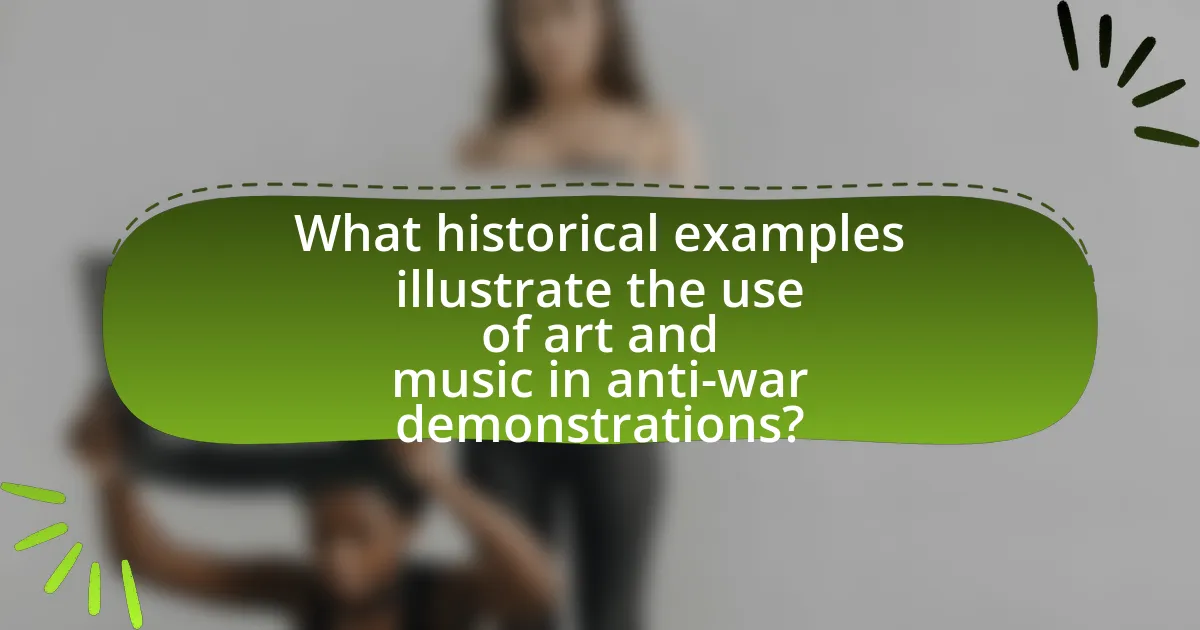
What historical examples illustrate the use of art and music in anti-war demonstrations?
Historical examples illustrating the use of art and music in anti-war demonstrations include the Vietnam War protests, where songs like “Give Peace a Chance” by John Lennon became anthems for the movement. These protests often featured visual art, such as posters and graffiti, conveying anti-war messages. Another significant instance is the 1969 Woodstock Festival, which served as a platform for artists like Joan Baez and Jimi Hendrix to express their opposition to the war through music. Additionally, the “Silent Majority” campaign utilized visual art to critique U.S. involvement in Vietnam, showcasing the power of artistic expression in mobilizing public sentiment against war.
Which notable anti-war protests featured significant artistic contributions?
Notable anti-war protests that featured significant artistic contributions include the Vietnam War protests of the 1960s and 1970s, where artists like Peter, Paul and Mary performed “Blowin’ in the Wind,” and the 2003 Iraq War protests, which saw the use of large-scale art installations and performances, such as the “Not in Our Name” campaign. These protests utilized music, visual art, and performance to convey messages against war, mobilizing public sentiment and fostering a sense of community among demonstrators. The Vietnam protests were marked by iconic imagery, such as the “Flower Power” movement, which symbolized peace and resistance, while the Iraq War protests featured banners and street theater that highlighted the human cost of conflict.
What role did music play in the Vietnam War protests?
Music served as a powerful tool for expression and mobilization during the Vietnam War protests. It provided a means for activists to convey their anti-war sentiments, unify participants, and raise awareness about the conflict. Iconic songs like “Fortunate Son” by Creedence Clearwater Revival and “Give Peace a Chance” by John Lennon became anthems of the movement, encapsulating the frustrations and hopes of a generation opposed to the war. These songs not only resonated with the protesters but also reached a wider audience, influencing public opinion and fostering solidarity among diverse groups. The integration of music into protests helped to create a shared cultural identity among demonstrators, making the anti-war message more relatable and impactful.
How did visual art shape public perception during the Gulf War protests?
Visual art significantly shaped public perception during the Gulf War protests by providing powerful imagery that conveyed anti-war sentiments and human suffering. Iconic pieces, such as posters and murals, depicted the horrors of war, influencing public opinion and mobilizing grassroots activism. For instance, the widespread use of the “No Blood for Oil” slogan in visual art highlighted the perceived motivations behind the war, resonating with a broad audience and fostering a sense of solidarity among protesters. This visual representation of dissent not only captured media attention but also played a crucial role in galvanizing public opposition, as evidenced by the large turnouts at protests and the growing anti-war movement during the early 1990s.
What lessons can be learned from these historical examples?
Historical examples of anti-war demonstrations utilizing art and music teach that creative expression can effectively mobilize public sentiment and foster solidarity. For instance, the Vietnam War protests in the 1960s showcased how songs like “Give Peace a Chance” by John Lennon galvanized collective action and communicated anti-war messages. Additionally, visual art, such as the iconic “The Peace Symbol,” became a universal emblem of the anti-war movement, illustrating the power of imagery in shaping public discourse. These instances highlight that art and music not only serve as tools for protest but also as means to inspire change and unify diverse groups around a common cause.
How can contemporary movements apply these lessons today?
Contemporary movements can apply the lessons from historical anti-war demonstrations by utilizing art and music as powerful tools for communication and mobilization. Historical examples, such as the anti-Vietnam War protests, demonstrated that songs like “Give Peace a Chance” became anthems that unified participants and conveyed messages of peace effectively. By creating relatable and emotionally resonant art, contemporary movements can foster community engagement and raise awareness about their causes. Research indicates that art can enhance emotional connection and inspire action, as seen in the 2017 Women’s March, where music and visual art played significant roles in expressing solidarity and resistance. Thus, leveraging art and music can amplify contemporary movements’ messages and strengthen their impact.
What are the enduring impacts of these artistic expressions on society?
Artistic expressions in historical anti-war demonstrations have enduring impacts on society by shaping public opinion, fostering community solidarity, and influencing political discourse. For instance, songs like “Give Peace a Chance” by John Lennon became anthems for the anti-war movement, galvanizing support and raising awareness about the consequences of war. Additionally, visual art, such as Picasso’s “Guernica,” serves as a powerful reminder of the horrors of conflict, prompting societal reflection and dialogue. These artistic forms not only document historical events but also inspire future generations to advocate for peace and social justice, demonstrating their lasting significance in cultural and political contexts.
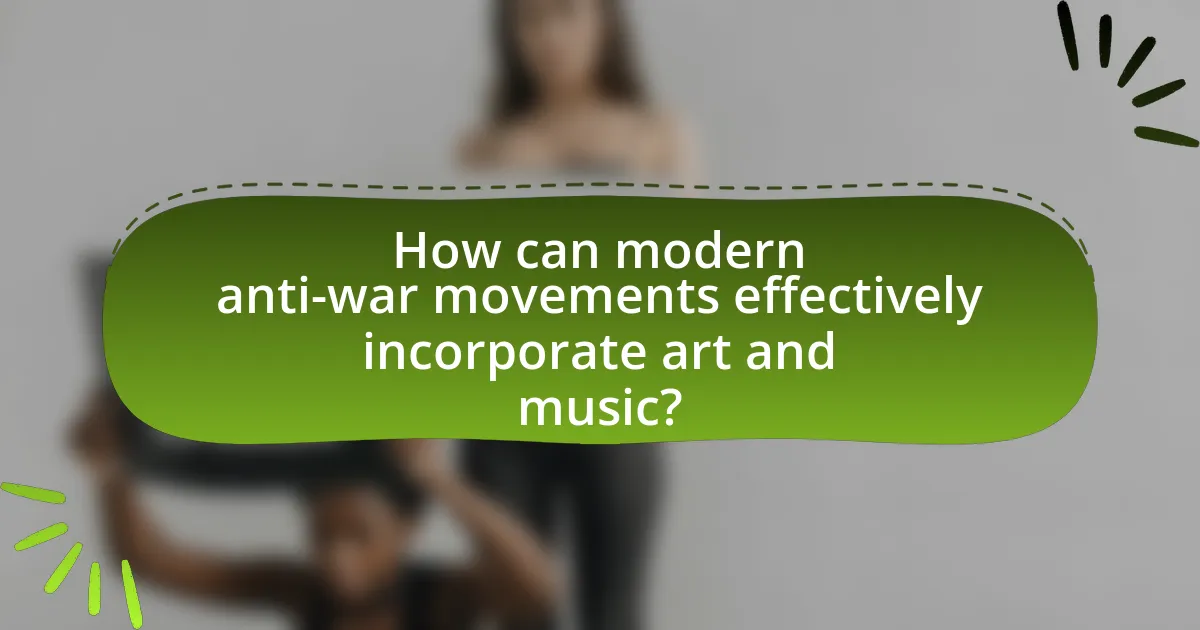
How can modern anti-war movements effectively incorporate art and music?
Modern anti-war movements can effectively incorporate art and music by using these mediums to convey powerful messages, evoke emotions, and foster community engagement. Art installations, murals, and performances can visually represent the consequences of war, while music can serve as a rallying cry, uniting individuals around a common cause. Historical examples, such as the use of protest songs during the Vietnam War, demonstrate how music can amplify messages and mobilize support. Additionally, collaborative art projects can create inclusive spaces for dialogue and reflection, enhancing the movement’s reach and impact.
What strategies can be employed to integrate art and music into protests?
Integrating art and music into protests can be effectively achieved through several strategies. First, organizers can incorporate live performances, such as musicians playing protest songs, which have historically galvanized crowds and conveyed messages, as seen in the 1960s anti-war demonstrations where artists like Joan Baez and Bob Dylan played pivotal roles. Second, visual art can be utilized by creating banners, murals, and installations that reflect the protest’s themes, similar to the iconic anti-war artwork of the Vietnam War era, which visually communicated dissent and solidarity. Third, community workshops can be organized to engage participants in creating art and music that express their collective grievances, fostering a sense of ownership and unity. Lastly, social media can be leveraged to share artistic expressions and music, amplifying the protest’s reach and impact, as demonstrated by the viral spread of protest songs during recent movements like Black Lives Matter. These strategies not only enhance the emotional resonance of protests but also create a lasting cultural legacy.
How can social media amplify the reach of artistic expressions in protests?
Social media amplifies the reach of artistic expressions in protests by providing a platform for rapid dissemination and engagement. Through platforms like Twitter, Instagram, and Facebook, artists can share their work instantly with a global audience, increasing visibility and participation in protest movements. For example, during the Black Lives Matter protests, artwork and music related to the movement went viral, reaching millions and inspiring further artistic contributions. This phenomenon is supported by data showing that social media posts related to protests can generate significant engagement, with hashtags often trending and reaching diverse demographics, thereby enhancing the overall impact of the artistic expressions involved.
What types of collaborative art projects can enhance anti-war messaging?
Collaborative art projects that can enhance anti-war messaging include community murals, performance art, and multimedia installations. Community murals allow artists and local residents to express collective sentiments against war, fostering a sense of unity and shared purpose. Performance art, such as theater or dance, can convey powerful narratives that highlight the human cost of conflict, engaging audiences emotionally and intellectually. Multimedia installations, which combine visual art, sound, and technology, can create immersive experiences that provoke thought and discussion about the implications of war. Historical examples, such as the “Peace Wall” in Belfast, demonstrate how collaborative art can serve as a platform for anti-war dialogue and activism, effectively reaching diverse audiences and amplifying the anti-war message.
What challenges do modern movements face in using art and music?
Modern movements face significant challenges in using art and music, primarily due to issues of accessibility, commercialization, and political censorship. Accessibility is a concern as not all communities have equal access to artistic resources or platforms, which can limit participation and representation. Commercialization poses a challenge as the art and music industries often prioritize profit over message, diluting the intended impact of the movements. Political censorship can restrict the expression of dissenting voices, making it difficult for artists and musicians to convey their messages freely. These challenges hinder the effectiveness of art and music as tools for social change in contemporary movements.
How can activists overcome censorship or backlash against artistic expressions?
Activists can overcome censorship or backlash against artistic expressions by utilizing digital platforms to disseminate their work widely and anonymously. The rise of social media and online art communities allows activists to share their messages without the constraints imposed by traditional media outlets or governmental censorship. For instance, during the Arab Spring, artists used platforms like Facebook and Twitter to share politically charged artwork, which garnered international attention and support, effectively circumventing local censorship. Additionally, collaborating with international organizations can provide activists with resources and visibility, further protecting their artistic expressions from backlash.
What resources are available for artists and musicians involved in activism?
Artists and musicians involved in activism can access various resources, including grants, organizations, and platforms that support their work. For instance, organizations like the Artist Relief Project provide financial assistance to artists facing hardship, while the Musician’s Foundation offers grants specifically for musicians in need. Additionally, platforms such as Patreon and Bandcamp enable artists to monetize their work directly from supporters, facilitating the funding of activist projects. Furthermore, networks like the Creative Coalition advocate for the arts and provide resources for artists engaged in social justice initiatives, ensuring they have the necessary support to amplify their messages effectively.
What best practices should be followed when using art and music in anti-war demonstrations?
Best practices for using art and music in anti-war demonstrations include ensuring that the messages conveyed are clear, inclusive, and resonate emotionally with the audience. Clear messaging allows participants to understand the purpose of the demonstration, while inclusivity fosters a sense of community and shared purpose. Emotional resonance can be achieved through powerful imagery and evocative music that reflect the experiences and consequences of war.
Additionally, utilizing local artists and musicians can enhance community engagement and support for the cause. Historical examples, such as the use of protest songs during the Vietnam War, demonstrate that music can unify participants and amplify their voices. Furthermore, integrating interactive art installations can encourage participation and dialogue among attendees, making the demonstration more impactful.

